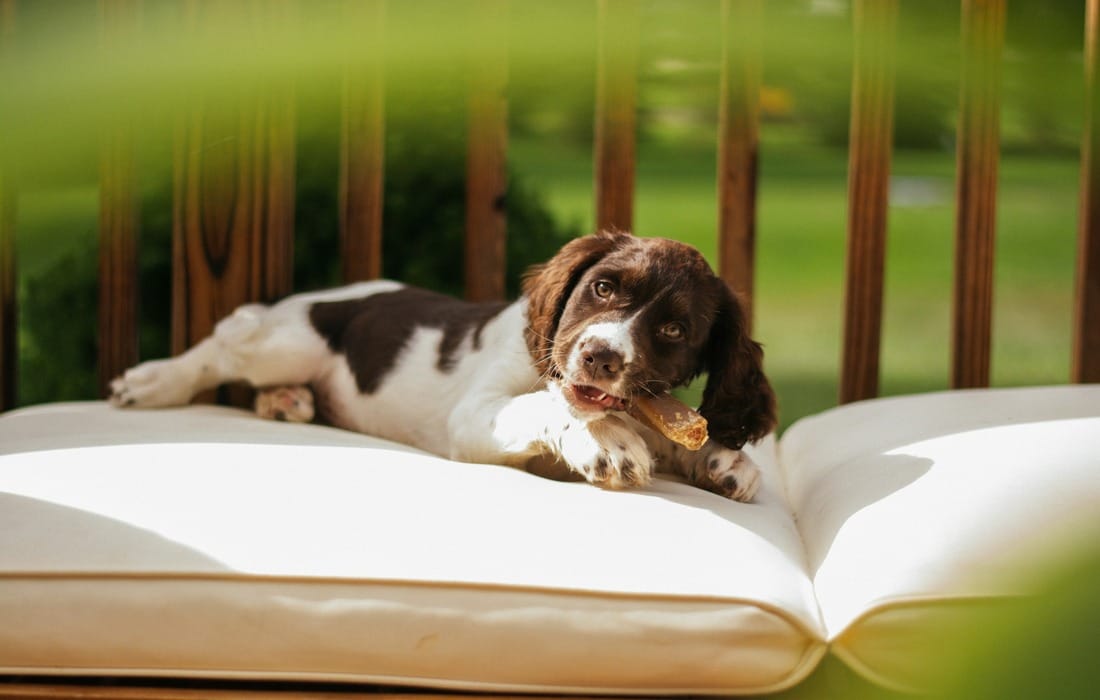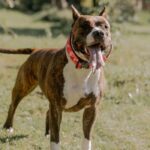As dog parents we’re always checking for the welfare of our furry friends. In case you’ve noticed that your dog has been scratching more than usual you might be dealing with a flea or tick infection . Fleas aren’t just a nuisance—they can pose serious health risks to your dog, from constant itching and skin infections to transmitting diseases, such as Lyme disease and Rocky mountain Spotted fever. Managing fleas effectively is essential for your pet’s comfort and well-being, and one of the simplest tools in your arsenal is a good flea shampoo. In this guide, I’ll walk you through top-rated shampoos, what makes them effective, and how to choose the right one for your furry friend.
Understanding Fleas and Their Impact on Dogs
If you’re dealing with fleas on your dog, you’re not alone. These tiny pests are more than just annoying; they can cause significant health problems for your furry friend. Understanding how fleas live, what risks they pose, and how to identify them early can make a big difference in keeping your dog healthy and comfortable.
The Flea Life Cycle
Did you know that fleas go through four stages in their life cycle? Knowing this is key to effective flea control because targeting all stages prevents the cycle from continuing. Here’s a breakdown:
- Egg Stage: Adult fleas lay eggs on your dog, but these fall off into the environment, landing in carpets, bedding, or grass. Eggs can hatch in as little as two days, depending on humidity and temperature.
- Larva Stage: The larvae are tiny, worm-like creatures that grow by feeding on “flea dirt” (adult flea feces) and organic debris.
- Pupal Stage: In this stage, larvae spin a cocoon and become pupae. It’s the most resistant stage, as the cocoon protects them from external threats like vacuuming or some insecticides.
- Adult Stage: Once conditions are right, the adult flea emerges and starts looking for a host—your dog.
The entire cycle, from egg to adult, can complete in as little as 14 days but may extend up to several months.
To truly stop fleas, you need to disrupt their life cycle at every stage. This is where a multi-pronged approach, including using the best shampoo for fleas on dogs, becomes essential. Shampoos can kill adult fleas on contact, but for lasting results, you’ll also need to address eggs and larvae in your dog’s environment.
Health Risks of Flea Infestation
Fleas aren’t just itchy—they can lead to real health problems for your dog. Here are the main risks:
- Skin Irritation and Allergies: Constant scratching from flea bites can irritate your dog’s skin, leading to redness, hot spots, or even infection. Some dogs develop flea allergy dermatitis (FAD), a severe allergic reaction to the flea’s saliva.
- Anemia: Severe infestations, particularly in puppies or small dogs, can cause anemia due to blood loss. This is a serious condition that might require veterinary care.
- Disease Transmission: Fleas can carry harmful diseases like Bartonella (cat scratch fever) and tapeworms. If swallowed during grooming, fleas can give your dog a tapeworm infection.
Want to know more about how fleas affect your dog’s health? Read this article from Cornell Veterinary for a deeper look.
Signs of Fleas on Your Dog
Catching fleas early can save your dog from discomfort. Here are common signs to watch for:
- Excessive Scratching or Biting: If your dog can’t seem to stop scratching certain areas—like their backside or belly—it could be fleas. Flea bites are intensely itchy!
- Hair Loss: Constant licking and scratching can cause patches of hair to fall out, especially around the tail or neck areas.
- Red, Irritated Skin: Look for redness, small scabs, or even raw, irritated spots, particularly near the tail base.
- Visible Fleas or Flea Dirt: Use a fine-tooth flea comb to part your dog’s fur. You might see small black specks (flea droppings) or even live fleas scurrying around.
How Flea Shampoos Work
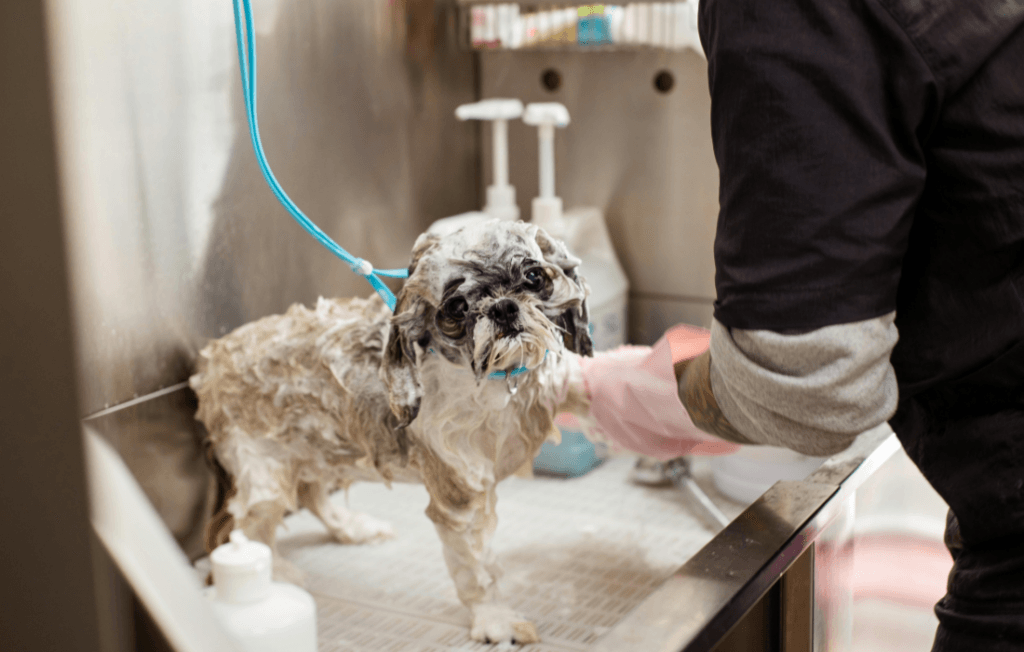

Flea shampoos are a crucial first step in managing flea infestations on your dog. They don’t just clean your pet’s coat—they’re specifically formulated to eliminate fleas on contact, providing instant relief. By addressing adult fleas directly, these shampoos can interrupt the flea life cycle and contribute to an overall flea control plan. But how do these products work, and what should you look for? Let’s break it down.
Key Ingredients to Look For
The effectiveness of a flea shampoo depends largely on its active ingredients. Understanding these ingredients will help you choose the best shampoo for fleas on dogs. Here are some of the most common and effective ones:
- Pyrethrin and Pyrethroids These are natural insecticides derived from chrysanthemum flowers and are known to kill fleas on contact. Pyrethroids, synthetic versions of pyrethrin, are often used for longer-lasting effects. Some shampoos containing these ingredients, such as Synergy Labs’ Flea & Tick Shampoo, also include soothing agents like aloe to protect irritated skin.
- Essential Oils Natural essential oils like cedarwood, peppermint, and clove are popular in natural alternatives. These oils work by repelling and suffocating fleas, while being gentler on your dog’s skin. A great example is Skout’s Honor Flea+Tick Shampoo, which combines cedarwood oil and peppermint for maximum effect.
- Aloe Vera and Lanolin These ingredients offer relief for skin that’s irritated from flea bites. Shampoos like the one by Vet’s Best combine natural oils with moisturizers to soothe your dog’s coat while targeting fleas.
When choosing a flea shampoo, always consider your dog’s individual needs. Some active ingredients may not be suitable for puppies, pregnant dogs, or pets with sensitive skin. Always check the label for safety recommendations.
How to Properly Use Flea Shampoo
Using flea shampoo correctly ensures it works effectively without causing irritation to your dog’s skin. Here’s a simple step-by-step guide to follow:
- Prepare Your Dog and the Area Start by brushing your dog’s coat to remove tangles and debris. This makes it easier for the shampoo to reach the skin. Choose an enclosed bathing area to prevent wet fleas from escaping to other parts of your home.
- Wet Your Dog Thoroughly Use lukewarm water to soak your dog’s coat completely. This helps the shampoo lather evenly and ensures fleas can’t hide in dry spots.
- Apply the Shampoo Generously Pour the shampoo onto your dog’s back and work it into a lather, covering all areas, including under the belly, tail base, and behind the ears. Be careful not to get the shampoo into your dog’s eyes or mouth.
- Let It Sit for 5–10 Minutes This step is crucial. Giving the shampoo time to work allows the active ingredients to kill fleas effectively. Some experts, like those at PetMD, recommend this delay as part of the process.
- Rinse Thoroughly Use plenty of water to rinse away the shampoo and dead fleas. Residual shampoo can irritate your dog’s skin or even attract dirt.
- Dry and Comb Your Dog Towel dry your dog and use a fine-tooth flea comb to remove any remaining parasites or debris. This is also a good time to inspect for any skin issues caused by the infestation.
Important Precautions:
- Test a small patch of skin with the shampoo first to check for any allergic reactions.
- Keep flea shampoo out of reach of children and other pets.
- Avoid overuse; most flea shampoos are not designed for daily use.
Top 10 Best Shampoos for Fleas on Dogs
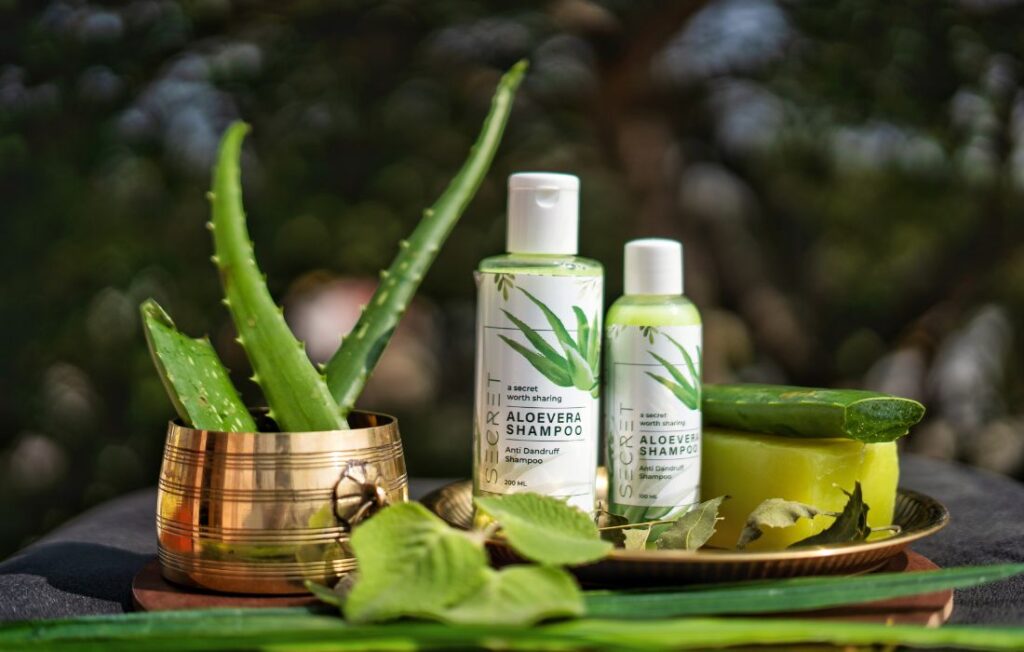

Finding the best shampoo for fleas on dogs can feel overwhelming with so many options on the market. Whether you’re managing an active infestation or looking for preventive care, each shampoo offers unique benefits. Below, I’ve reviewed ten top-rated options to help you make an informed decision.
1. Adams Plus Flea & Tick Shampoo with Precor
Adams Plus Flea & Tick Shampoo with Precor is a standout product for combating fleas and ticks. Its key ingredient, Precor (an insect growth regulator), not only kills adult fleas but prevents eggs from hatching for up to 28 days. This extended residual effect makes it a go-to choice for persistent infestations. Enriched with aloe, oatmeal, and lanolin, it’s gentle enough for most dogs, including those with sensitive skin.
2. Richard’s Organics Flea and Tick Shampoo
For owners looking for a natural option, Richard’s Organics shines. Packed with essential oils like cinnamon, clove, cedarwood, and peppermint, it effectively kills fleas and ticks while soothing skin. It’s an ideal choice for dogs with sensitive or irritated skin since it excludes harsh chemicals.
3. Vet’s Best Flea + Tick Advanced Strength Shampoo
Vet’s Best offers a powerful plant-based solution. Active ingredients like peppermint and rosemary oils tackle fleas effectively while being gentle on your dog’s coat. It’s particularly appealing for environmentally conscious buyers who want natural, yet robust, results.
4. Bio-Groom Flea & Tick Dog Shampoo
The Bio-Groom flea and tick shampoo is designed to kill fleas and ticks while being gentle on your dog’s skin. It’s suitable for both dogs and cats and helps cleanse and deodorize the coat. It also contains no harsh chemical that strip natural oils from your pet’s coat.
5. Mycodex Flea and Tick Shampoo P3
For severe flea infestations, Mycodex P3 hits hard. Its triple-strength formulation is designed to eliminate adult fleas on contact. Plus, it includes conditioning agents like aloe and coconut extract to leave your dog’s coat soft and shiny.
6. Hartz UltraGuard Rid Flea & Tick Shampoo for Dogs
The Hatz Ultraguard shampoo collection is one of the most complete in the market. Each shampoo is formulated to effectively kills fleas and ticks on contact while cleansing and deodorizing your dog’s coat. It features a fresh scent and is suitable for dogs and puppies aged 6 months and older. The formula includes oatmeal or citrus scent to soothe dry or irritated skin. Regular use can help prevent reinfestation
7. Sentry PRO Flea and Tick Shampoo
If speed is your priority, Sentry PRO delivers. It kills fleas almost instantly upon contact and continues fighting flea eggs for 30 days. The shampoo also deodorizes while conditioning, leaving your dog smelling fresh.
8. TropiClean Natural Flea & Tick Dog Shampoo
Formulated with natural essential oils like clove, lemongrass, cedarwood, and cinnamon, TropiClean Natural Fea & Tick shampoo effectively repels and kills fleas, ticks, and mosquitoes on contact. It’s free from pyrethrin and permethrin, making it a natural alternative for pest control. The shampoo also cleanses and exfoliates your dog’s skin and coat, leaving a pleasant citrus aroma.
9. Paws & Pals Natural Flea & Tick Dog Shampoo
The Paws & Pal all-natural shampoo combines essential oils like rosemary, cedarwood, and peppermint to repel and eliminate fleas and ticks. It also includes soothing ingredients such as aloe vera and oatmeal to moisturize and relieve itchy skin. The formula is free from harsh chemicals, making it safe for regular use and suitable for dogs with sensitive skin.
10. Wahl Flea & Tick Repelling Dog Shampoo
Wahl Flea & Tick Repelling all-natural shampoo combines essential oils like rosemary, cedarwood, and peppermint to repel and eliminate fleas and ticks. It also includes soothing ingredients such as aloe vera and oatmeal to moisturize and relieve itchy skin. The formula is free from harsh chemicals, making it safe for regular use and suitable for dogs with sensitive skin.
Comparison Table of Flea Shampoos
Choosing the right flea shampoo for your dog can make a world of difference in fighting off those pesky parasites. With so many options on the market, it helps to have a quick side-by-side comparison to understand their key ingredients, effectiveness, and features. Below is a table that summarizes some of the best flea shampoos for dogs based on performance and skin care benefits.
| Shampoo | Effectiveness | Active Ingredients | Benefits | Drawbacks |
|---|---|---|---|---|
| Adams Plus Flea & Tick Shampoo with Precor | Kills adult fleas, ticks, and prevents flea eggs from hatching for 28 days. | Precor, Pyrethrins, Aloe, Lanolin | Long-lasting results; moisturizes skin. | Not ideal for very young puppies under 12 weeks. |
| Richard’s Organics Flea & Tick Shampoo | Natural flea and tick control with essential oils. | Cinnamon, Clove, Cedarwood Oils | All-natural, safe for sensitive skin. | Shorter duration of effectiveness. |
| Vet’s Best Flea + Tick Advanced Strength Shampoo | Robust plant-based formula kills fleas instantly. | Peppermint, Rosemary Oils | Gentle, eco-friendly ingredients. | Strong smell may not suit every owner’s preference. |
| Sentry PRO Flea & Tick Shampoo | Provides immediate flea killing and 30-day egg control. | Permethrin, Pyriproxyfen | Quick action; deodorizes and conditions fur. | Not suitable for puppies or cats. |
| Bio-Groom Flea & Tick Dog Shampoo | Kills fleas and ticks while cleansing and deodorizing the coat. | Pyrethrins, piperonyl butoxide technical, n-octyl bicycloheptene dicarboximide | Gentle formula; safe for both dogs and cats; pleasant scent. | Can’t be use on puppies |
| Mycodex Flea and Tick Shampoo P3 | Heavy-duty shampoo for severe flea infestations. | Pyrethrin, Aloe, Coconut Extract | Great for persistent flea issues; leaves the coat shiny. | Requires careful handling of potent chemicals. |
| Paws & Pals Natural Flea & Tick Dog Shampoo | Repels fleas and ticks using natural essential oils; gentle on skin. | Rosemary Oil, Cedarwood Oil, Aloe Vera | All-natural, soothing formula; safe for frequent use. | Does not kill fleas on contact; requires repeated application. |
| Wahl Flea & Tick Repelling Dog Shampoo | Helps repel fleas and ticks while conditioning the coat. | Rosemary Oil, Mint, Cedarwood Oil | Gentle and safe for sensitive skin; eco-friendly formula. | Less effective against severe flea infestations. |
| TropiClean Natural Flea & Tick Dog Shampoo | Kills fleas, ticks, and larvae on contact while repelling future infestations. | Clove Oil, Lemongrass Oil, Cedarwood Oil, Sesame Oil | Natural ingredients; pleasant citrus scent; no harsh chemicals. | Requires frequent reapplication for continued protection. |
| Hartz UltraGuard Rid Flea & Tick | Kills fleas and ticks on contact while cleansing the coat. | Phenothrin, Aloe Vera | Affordable; leaves fur soft and shiny. | Not recommended for puppies under 6 |
Addressing Common Safety Concerns
When it comes to treating fleas on dogs, many pet parents worry about the safety of flea shampoos. It’s important to know that not all shampoos are created equal, and selecting the right one involves understanding your dog’s specific health needs. Let’s address the most common concerns to guide you toward making better decisions for your furry friend.
Suitability for Puppies and Senior Dogs
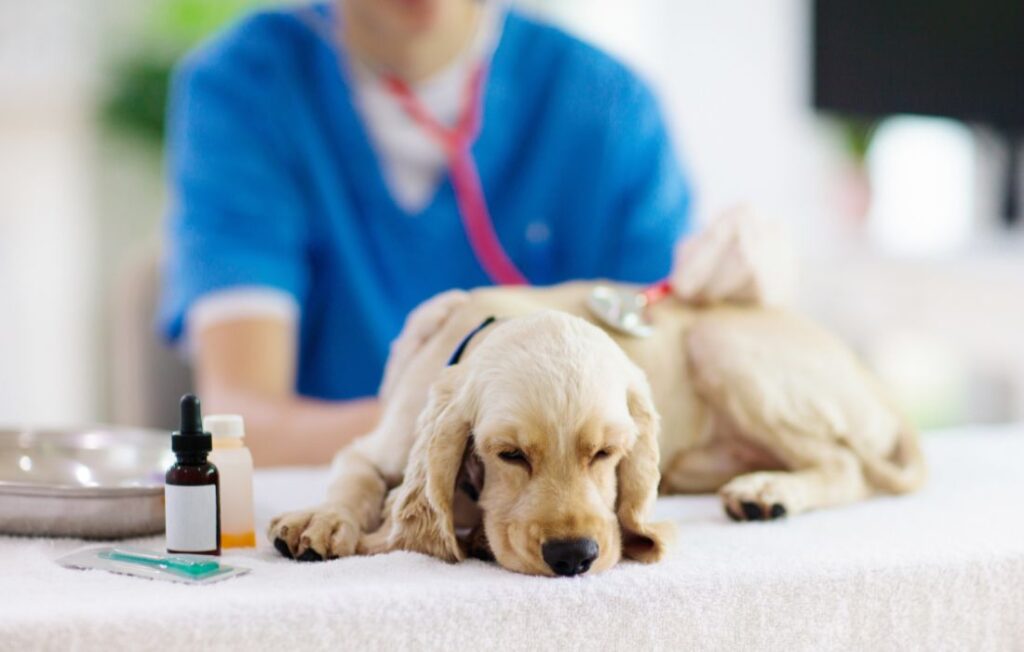

Puppies and senior dogs have more delicate systems than healthy adult dogs, so special care must be taken to select a shampoo that won’t harm them. For puppies, look for labels specifying that the product is safe “for puppies over 12 weeks of age” or “gentle for young dogs.” Products like Adams Plus Flea & Tick Shampoo cater specifically to sensitive puppy skin while effectively treating fleas.
Senior dogs may experience weakened immune systems or other health conditions, such as arthritis or dry skin. For them, avoid shampoos with harsh chemicals like pyrethrins, which could irritate their skin or impact their overall well-being. Instead, choose a product with calming and moisturizing ingredients like aloe or oatmeal, which are gentler alternatives.
Make sure to check with your vet before using any flea treatment product, especially if your dog has underlying medical conditions, to avoid unnecessary health risks.
Managing Skin Sensitivities and Allergies
Dogs with sensitive skin or allergies need shampoos designed to minimize irritation while still being effective against fleas. Common signs of sensitivity include redness, itching, or dryness after regular baths. If your dog has any of these symptoms, the best solution is to opt for natural or hypoallergenic flea shampoos.
Look for flea shampoos that are free of artificial dyes and fragrances, which often trigger allergic reactions. Products featuring colloidal oatmeal, chamomile, or coconut oil can provide soothing relief while keeping fleas at bay. Examples include brands like Richard’s Organics or Vet’s Best Flea + Tick Shampoo, which focus on natural, plant-based ingredients.
Before using any new shampoo, conduct a patch test. Apply a small amount on a less noticeable area of your dog’s skin and wait 24 hours to see if there’s any adverse reaction. If your dog has a history of severe allergies, consult your vet to explore alternative flea control options that might work better for your pup.
How Often Should You Use Flea Shampoo?
One of the most common questions is how often to bathe your dog with flea shampoo. While flea shampoos are effective, overuse can do more harm than good. Frequent baths can strip your dog’s coat of natural oils, leading to dry and irritated skin. Industry recommendations, such as those cited in PetMD’s guide, suggest limiting flea shampoo use to no more than once a week during active infestations.
For maintenance, use the shampoo once a month or as directed on the product packaging. In between flea shampoo baths, regular dog shampoos with added moisturizers can help keep your pet’s coat healthy without reintroducing chemicals.
It’s also crucial to consider the overall flea control program. Flea shampoos kill adult fleas but don’t necessarily eliminate eggs or larvae, which means follow-up treatments like oral preventatives or flea collars may be necessary. Consistency with these additional methods will reduce the chances of recurring infestations.
By being mindful of your dog’s age, skin sensitivities, and the appropriate use frequency of flea shampoos, you can ensure your furry friend stays safe, comfortable, and flea-free.
Flea Control Beyond Shampoos
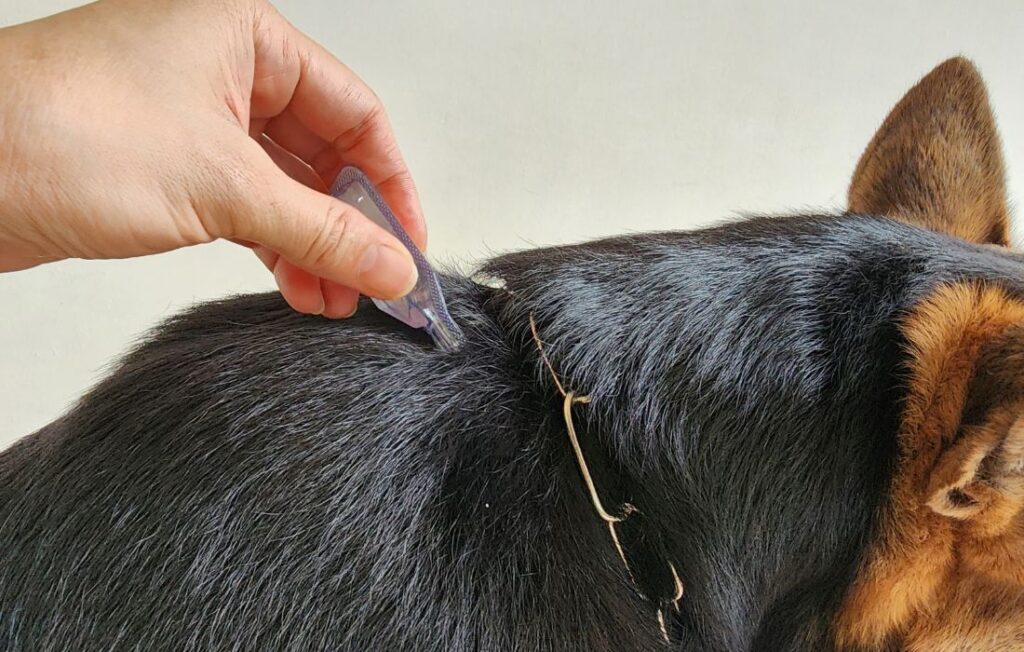

While flea shampoos are effective at killing adult fleas on contact, they are not a standalone solution. Tackling fleas requires a comprehensive approach—one that combines effective treatments for your pet with preventative measures in their environment. Below, I’ll explore some alternatives that can complement flea shampoos to create a stronger defense against infestations.
Flea Collars and Spot-on Treatments
Flea collars and spot-on treatments are excellent tools that work alongside shampoos to provide ongoing protection for your dog. These treatments target fleas at different stages of their life cycle, ensuring your pet remains safeguarded even after a bath.
Flea collars, such as those made with natural essential oils or modern formulas, provide long-lasting protection. They slowly release active ingredients that repel or kill fleas, keeping your dog protected for weeks or even months. Newer flea collars are safer and more effective than older models, making them a reliable choice for extended flea control. For more information, check out this guide.
Spot-on treatments are a great alternative if you’re looking for quick, hassle-free application. These liquid treatments are applied directly to your dog’s skin, usually between the shoulder blades, where they are absorbed and distributed throughout the skin and fur. Spot-on solutions often include active ingredients that kill fleas and prevent eggs from hatching, working as a proactive shield against reinfestation.
By combining these options with regular shampoo baths, you create a layered defense that ensures fleas are tackled at every stage of their life cycle.
Environmental Flea Prevention
Managing your dog’s surroundings is just as important as treating them directly. Since fleas often lay eggs in carpets, bedding, and outdoor areas, proactive environmental control is key to breaking their life cycle and preventing reinfestation.
Here are some practical tips:
- Wash Bedding and Fabrics Frequently Your dog’s bedding, blankets, and any other soft materials they frequently use can harbor flea eggs and larvae. Washing these items in hot water at least once a week can help eliminate the problem.
- Vacuum Regularly Carpets and rugs serve as breeding grounds for fleas. Vacuuming your home daily can reduce eggs, larvae, and adult fleas from your environment. Be sure to empty the vacuum bag or canister into a sealed trash bag to prevent fleas from escaping back into the house.
- Steam Clean Carpets and Upholstery For a deeper clean, consider steaming your carpets and furniture. High temperatures can effectively kill all stages of fleas, including resistant pupae.
- Use Outdoor Flea Treatments If your dog spends time outside, focus on maintaining your yard. Clear out any leaf piles, brush, or tall grass, as these areas are ideal for fleas to thrive. For added protection, you can apply pet-safe insecticides to shaded, damp spots where fleas are likely to hide. For more information you can check the following advice for controlling fleas around your home from EPA
Final Thoughts
Choosing the right shampoo to treat a flea infestation is an important step in keeping your furry friend comfortable and healthy. Remember that flea shampoos work best as part of a broader flea control strategy that includes prevention and environmental management. If your dog continues to struggle with fleas despite regular treatment, reach out to your veterinarian for personalized advice. Combining the right products with proactive care ensures your dog stays happy, itch-free, and protected year-round.





